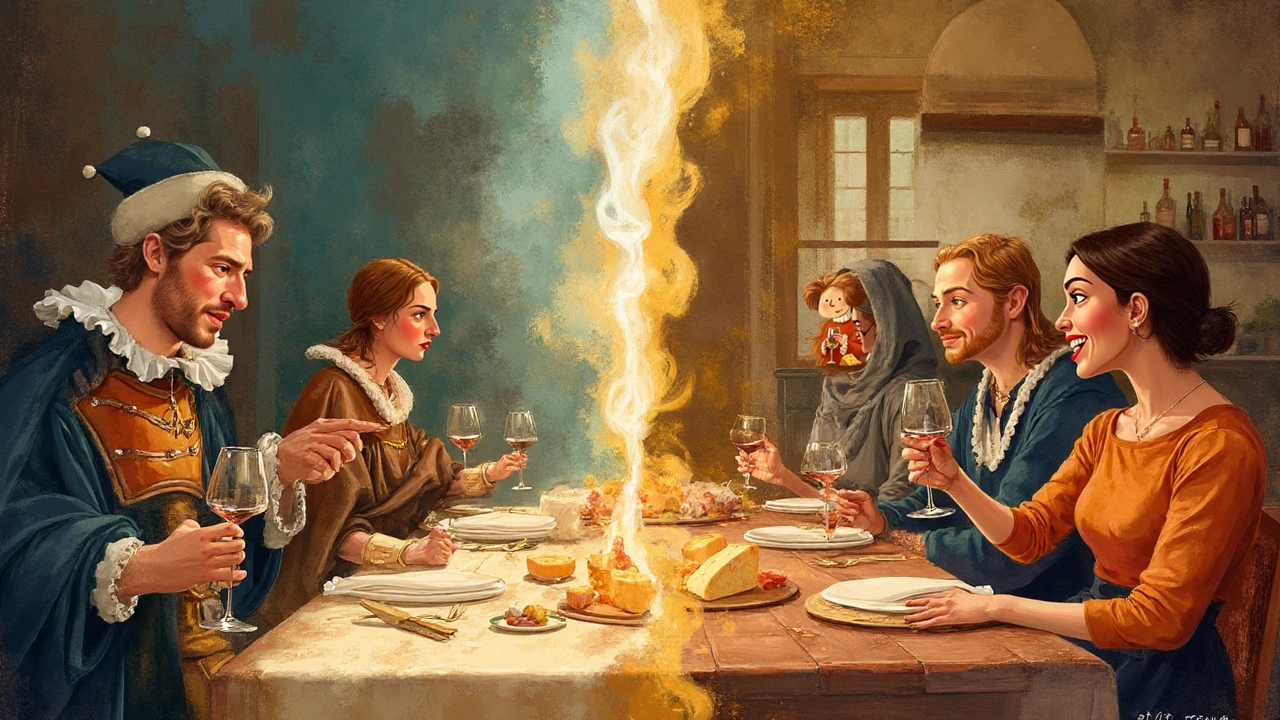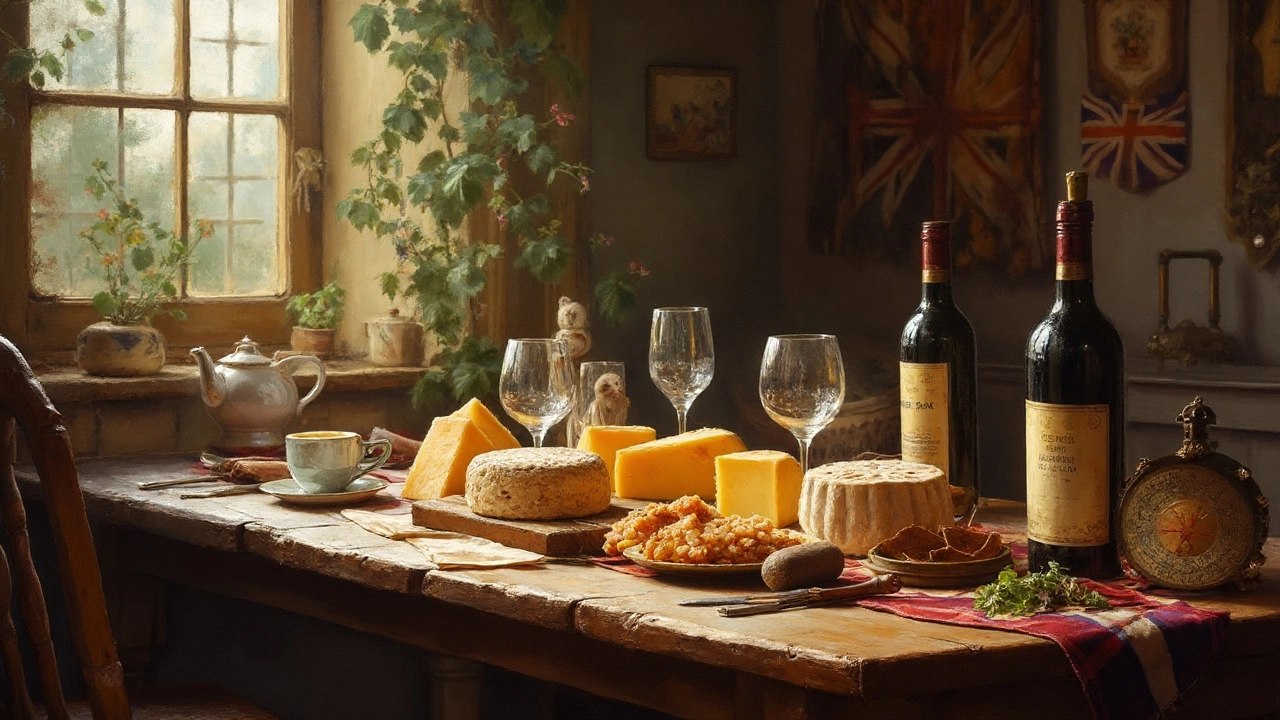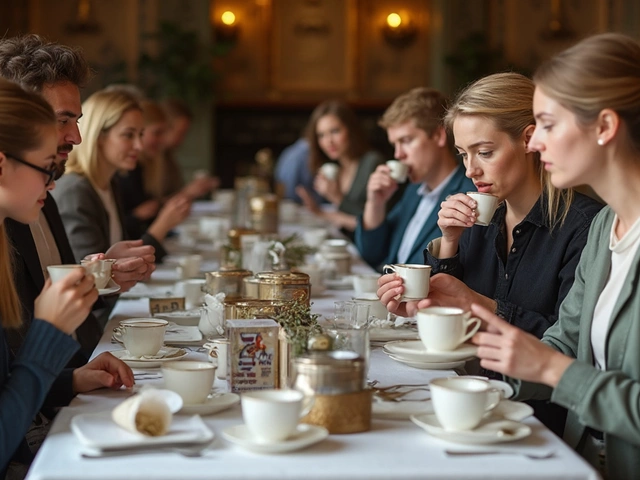If someone told you cheese and wine were just tossed together because they were sitting around the farm, they’re selling you short. Here’s a shocker: cheese and wine had nothing to do with fancy sommeliers originally—it was a survival move long before fancy restaurants or Instagrammable cheese boards. Yet, nothing pulls in a crowd like these two. And while “they just go together” gets tossed around all the time, the real reasons are way juicier—and way more useful when you want to impress your mates.
The Odd Couple: Cheese and Wine Through History
Grab a chunk of cheese and you’re biting into a story that goes back over 7,000 years. Wine’s history is almost as old. But the weird bit is—they didn’t hook up as a gourmet duo until way later. Picture medieval Europe. Farmers made cheese to keep milk from rotting and wine because water was basically dodgy. Cheese would use up the extra milk, while wine was drunk instead of (or with) water because clean drinking water wasn't a thing. Both lasted way longer than bread or fruit, so locals set them on the table together simply because that’s what they had. It was survival first, not luxury.
Fast forward to the monasteries of France and Italy—monks weren’t just praying, they were perfecting cheese and wine. Some monasteries in Burgundy were legendary for making both, and pairing happened naturally. Taste-wise, cheese mellowed out the sharp edges in wine and vice versa. So next time someone waxes poetic about “ancient traditions,” just remember old monks were more practical than poetic.
But there’s more. During travels in 17th and 18th century Europe, folks began noticing that certain cheeses from one region went really well with the local wine. This wasn’t planned—it happened because both cheese and wine drew flavors from the same earth, animals, grass... even the weather. Terroir, that fancy French word, is just how everything around the cheese and wine shapes taste. A seriously geeky study from the University of Burgundy dug into this, showing that cows eating wildflowers in summer gave cheese a nutty twist that matched wines from summer-picked grapes.
By the late 1800s, cheese and wine were on the menu together in posh social circles—not just out of necessity, but for their taste. If you ever wondered why, for instance, Camembert nails it with French Pinot Noir but feels lost with a big Aussie Shiraz, terroir is the magic ticket.
The Science Behind What Your Taste Buds Love
Let’s get nerdy for a second: when cheese and wine mix in your mouth, it’s kind of like a chemical tango. Wine has acids and tannins that can make your mouth feel dry or puckery; cheese has fats and proteins that soften those sharp notes. A recent experiment by a team at the Centre for Taste in Dijon hooked people up to sensors while they ate cheese with wine. The more fatty the cheese, the less harsh the wine tasted. White, red, rosé—it worked across the board.
There’s more than just taste going on. Cheese coats your tongue with a film of fat. Then, when you sip wine, the acid and fruit in the wine slice through that fat, waking up flavors in both. Think of it as pressing “boost” on taste. Soft, creamy cheeses like Brie actually reduce the puckering effect of red wine tannins. Ever notice how eating sharp cheddar before a sip of Cabernet somehow makes the wine silkier? That’s the fat working its magic. Conversely, a lean, crisp white like Sauvignon Blanc scrubs away the salty tang of a goat cheese, keeping your mouth fresh instead of cloying.
Even nose and smell come into play. Wine’s aroma molecules are boosted by the proteins in cheese, so that floral or fruity whiff gets even punchier after a bite. There’s a famous study from 2015 published in the “Journal of Food Science” that found wine flavor perceptions change dramatically after cheese. For volunteers in the study, the fruitiness in rosé and red wine jumped after biting blue cheese, while bitterness faded with Brie. So the myth that cheese “dulls” wine? Complete rubbish—in lots of combos, cheese makes wine flavours louder.
Your taste perception is easily manipulated by these pairing effects. Pairing the wrong cheese with the wrong wine doesn’t just taste meh, it can make the wine feel bitter or metallic. That’s why pros always harp on getting the balance right: soft with soft, strong with strong. There’s legit science behind those rules, not just tradition.

Practical Tips for Pairing: What Actually Works
Okay, enough theory. Want to nail your next cheese and wine night? Here’s how to avoid the rookie mistakes most people make. Rule number one: match intensity. That means bold cheese calls for bold wine, lighter cheese for lighter wine. If you toss blue Stilton next to a delicate Pinot Grigio, nobody wins—it's like yelling at a meditation session.
Here’s a table you can screenshot for later:
| Cheese Type | Example | Best Wine Match | Why It Works |
|---|---|---|---|
| Soft & Creamy | Brie, Camembert | Pinot Noir, Chardonnay | Creaminess tames acidity; subtlety needed |
| Hard & Aged | Cheddar, Manchego | Cabernet Sauvignon, Rioja | Fat content smooths out wine’s tannin edge |
| Blue | Stilton, Roquefort | Port, Sauternes | Sweet + salty = balanced heaven |
| Goat’s Milk | Chèvre, Valdeon | Sauvignon Blanc | Freshness cleanses palate; tang complimented |
If you’re at the bottle shop with no clue what to pick, just think local: French cheese? Go for a French wine. Italian cheese? Pair with Italian drops. They were literally designed together over centuries. If you’re mixing a platter, lay out your cheeses from mildest to strongest, and tell your mates to start light and finish bold—your mouth will thank you.
I’m a big advocate for throwing in a wild card. Try a bold blue cheese with dark, chocolatey stout beer or even smoky whisky. Not all pairings need wine—there’s a reason cheese pops up everywhere from craft beer bars to whisky tastings. Those rules about “only red with cheese” are made for breaking.
Busting Myths: Mistakes Everyone Makes
People get stuck thinking any cheese pairs well with any wine. Here’s where things go south. Super salty cheeses with huge, tannic reds? It makes both taste kind of metallic and harsh—think of licking a battery. Another classic error: creamy cheeses with heavily oaked whites. You’ll just taste bland butter on bland butter.
The “red wine only” myth will not die, but it needs to. Some cheeses, especially the fresh, tangy types (like chèvre), taste way better with crisp white wines or even very dry sparkling. There’s a genuine reason: whites have more acid, which powers through cheese fats and resets your tongue. Reds with too many tannins can turn funky with soft cheeses and taste off.
The “serve cheese cold” idea is also a screw-up. Cheese is best at room temp—about 21°C here in Sydney (and most places). Cold cheese dulls taste, so let it breathe for at least 40 minutes before eating. Same thing with wine: don’t serve reds hot or whites ice-cold. A little temperature tweak brings out both the wine’s and the cheese’s best.
If you want to dial it in—a trick from an actual cheese judge I met—test the match by taking a bite, chewing, then sipping wine straight after. If the flavors clash or vanish, it’s not the pair for you. If both seem to get louder or more interesting, you’ve nailed it.

Cheese and Wine Pairing in the Modern World: What’s New?
Modern winemakers and cheesemongers aren’t stuck in Europe anymore. Australia leads the way with bold combos (think Manchego with Hunter Valley Semillon), and street-level cheese shops are catching on. More artisan cheesemakers are experimenting with milk from sheep, goats, even buffalo for unique flavours that match local wines.
Cultural mashups are blowing up. Ever had blue cheese on a sushi roll with crisp sake, or fresh mozzarella with Pet Nat? Sydney’s food scene is packed with wild pairings, and you don’t need to follow any book. I even chatted with a cheesemaker at the Carriageworks Market who matches a smoked cheddar with Aussie cider. Surprisingly, it’s a knockout.
Plant-based, vegan cheeses make pairing a whole new game. Cashew brie pairs great with aromatic whites like Gewurztraminer or with sparkling wine. As more folks skip dairy, these alternatives are getting sharper in flavour, and wine shops are happy to suggest interesting combos. Just ask—people love showing off their tasty hacks.
Even science is upping its game. There’s ongoing research (CSIRO released a snapshot in May 2025) into mouthfeel, showing how plant-based cheeses interact differently with wine acids. These combos might soon have their own dedicated pairing events—watch this space.
If you’re really into numbers, here’s a fun stat: according to Australia's biggest cheese festival (Mould), over 65% of visitors said pairing cheese and wine made both taste better. That’s not marketing—that’s people actually tasting the boost.
The bottom line: cheese and wine got together out of necessity, but we stuck with it because it just works. Every bite and sip tells a wicked story, and if you’d rather make up your own rules, go for it. That’s what keeps the combo alive, fresh, and way more interesting than following the same old script.


